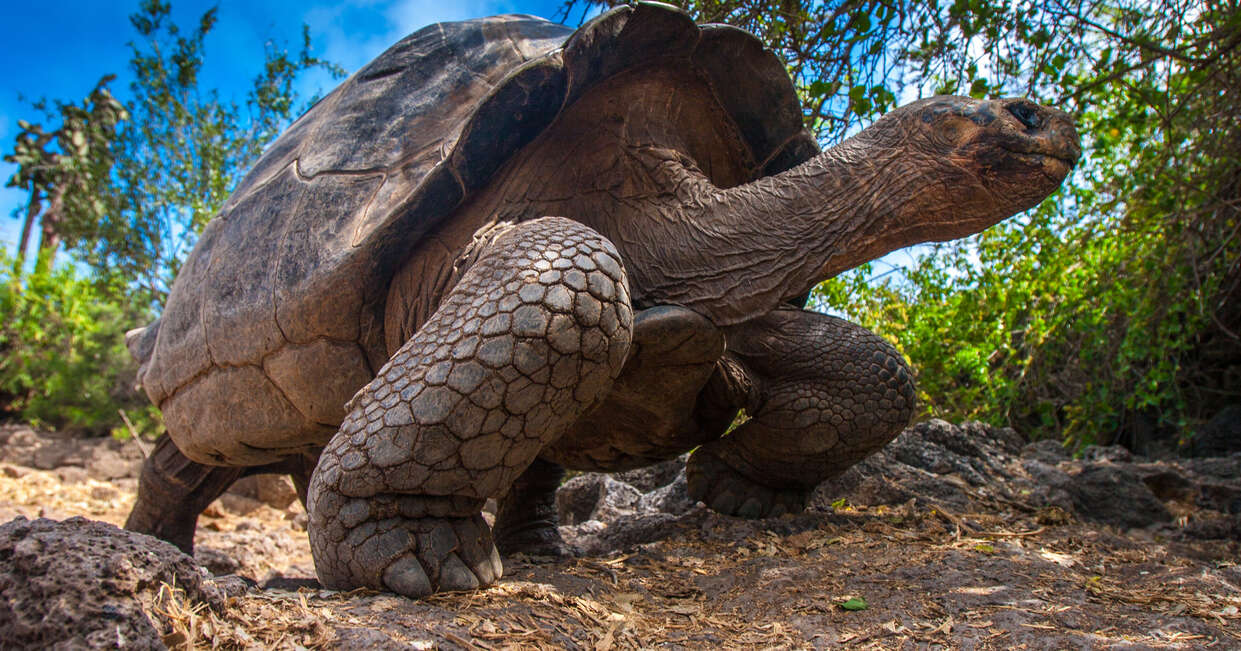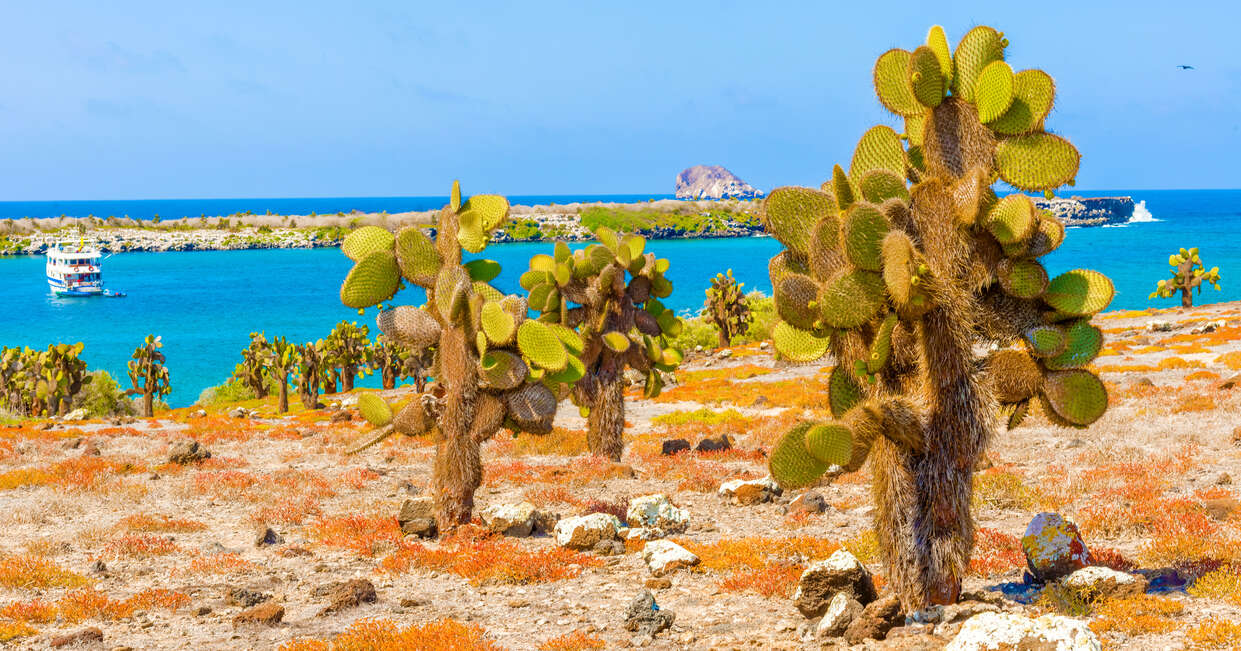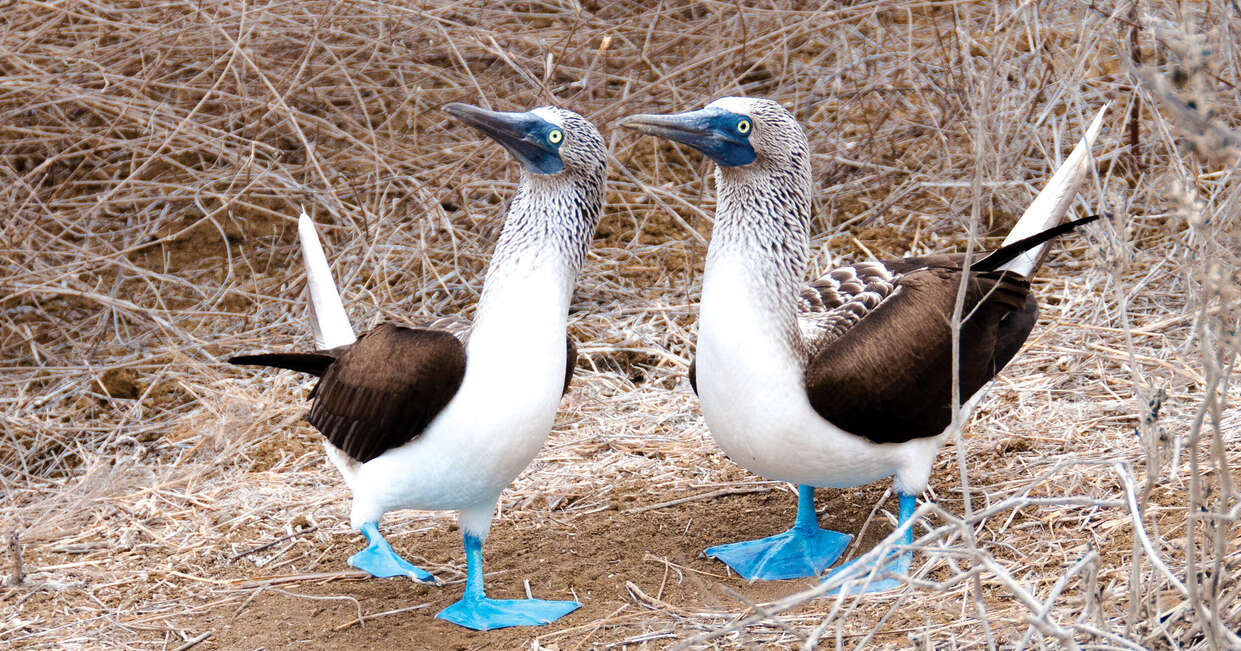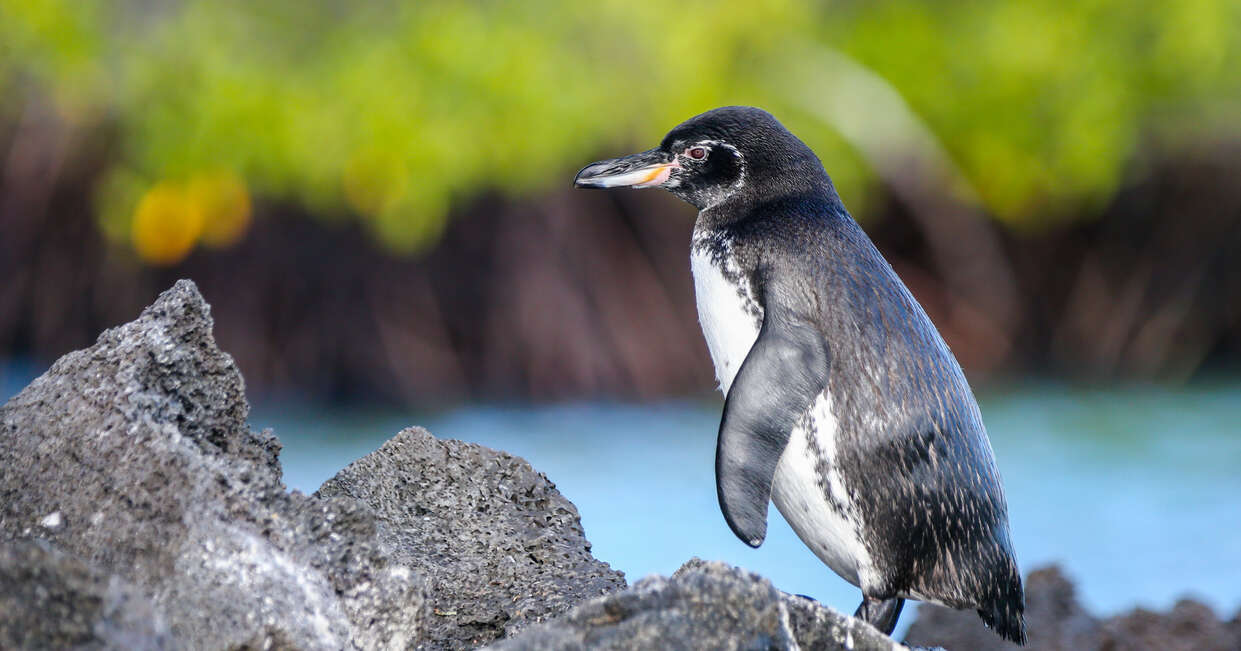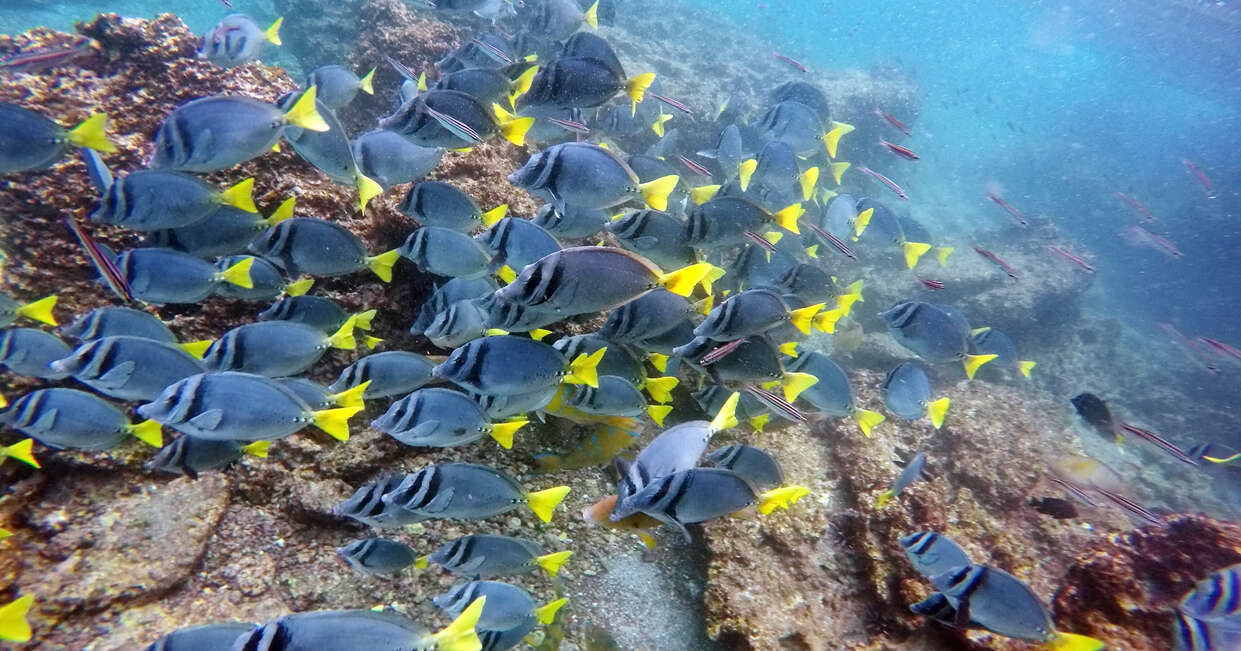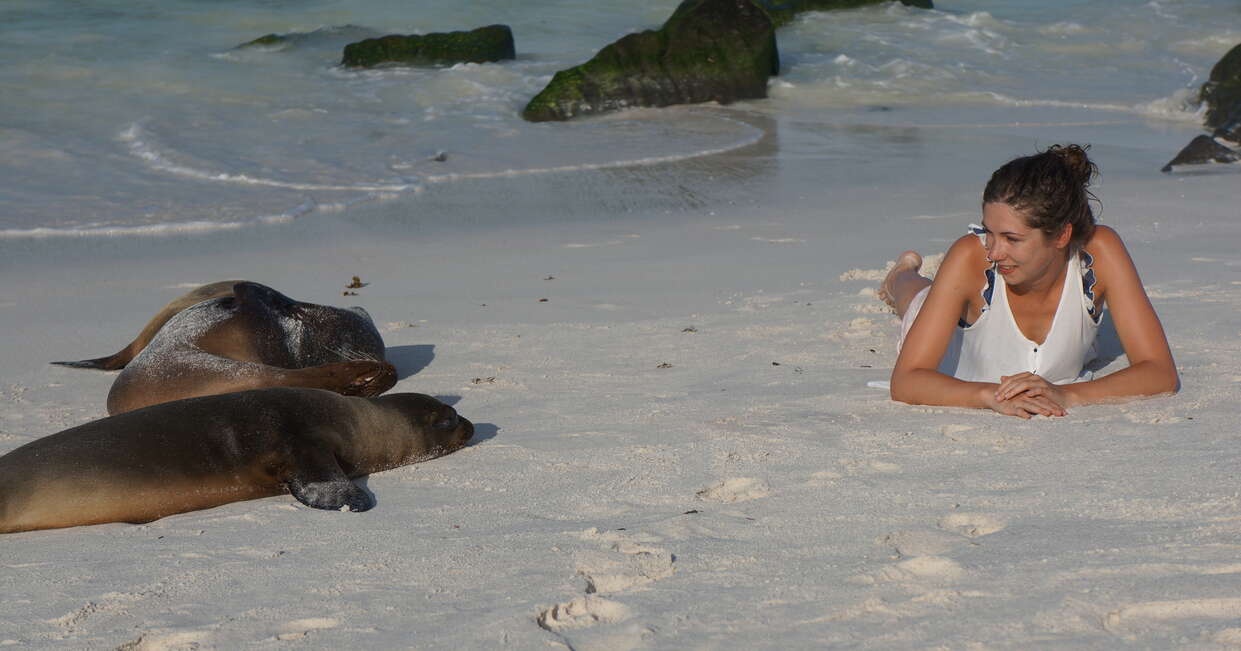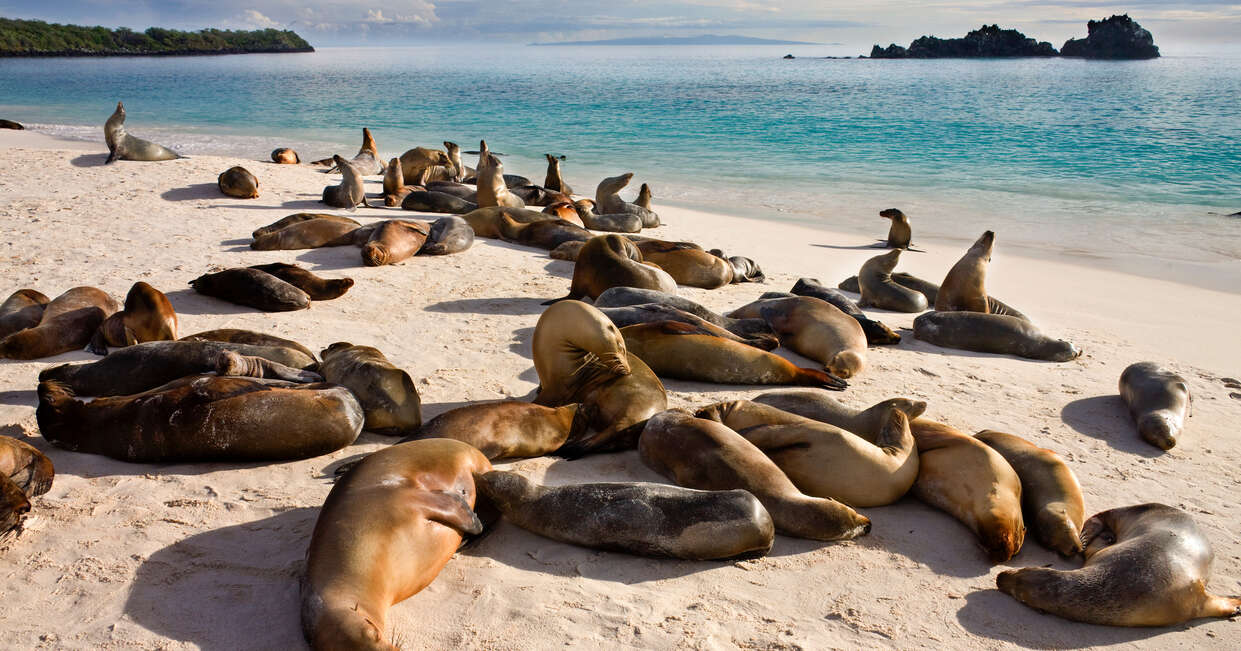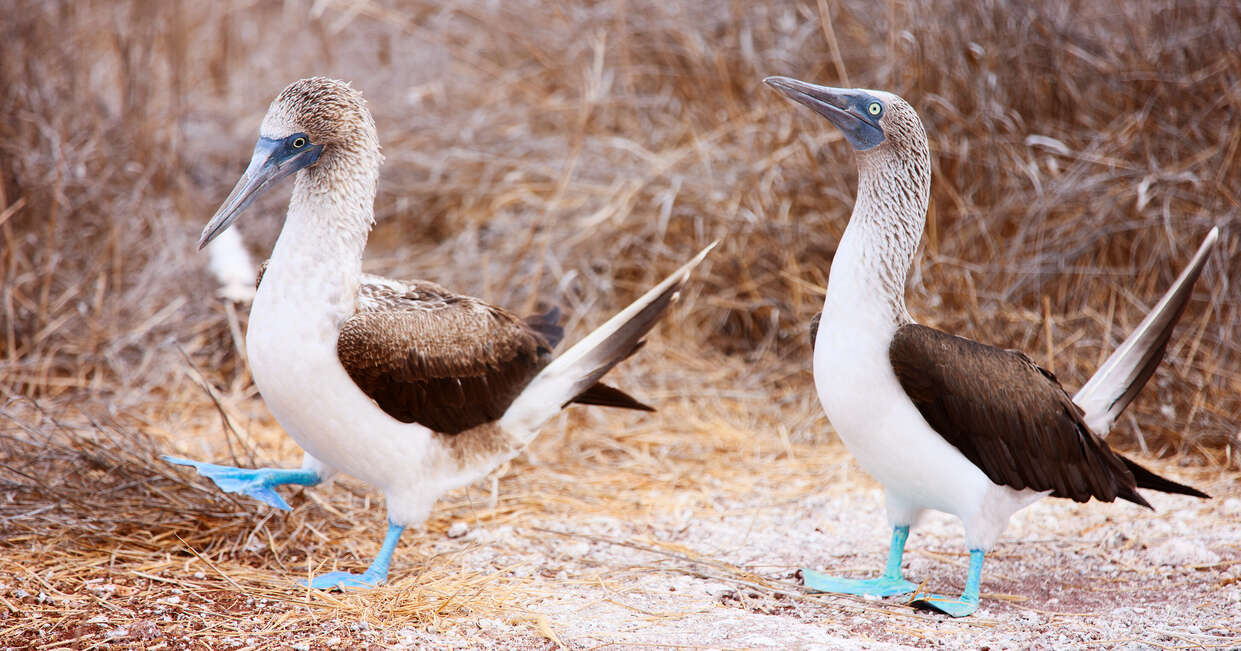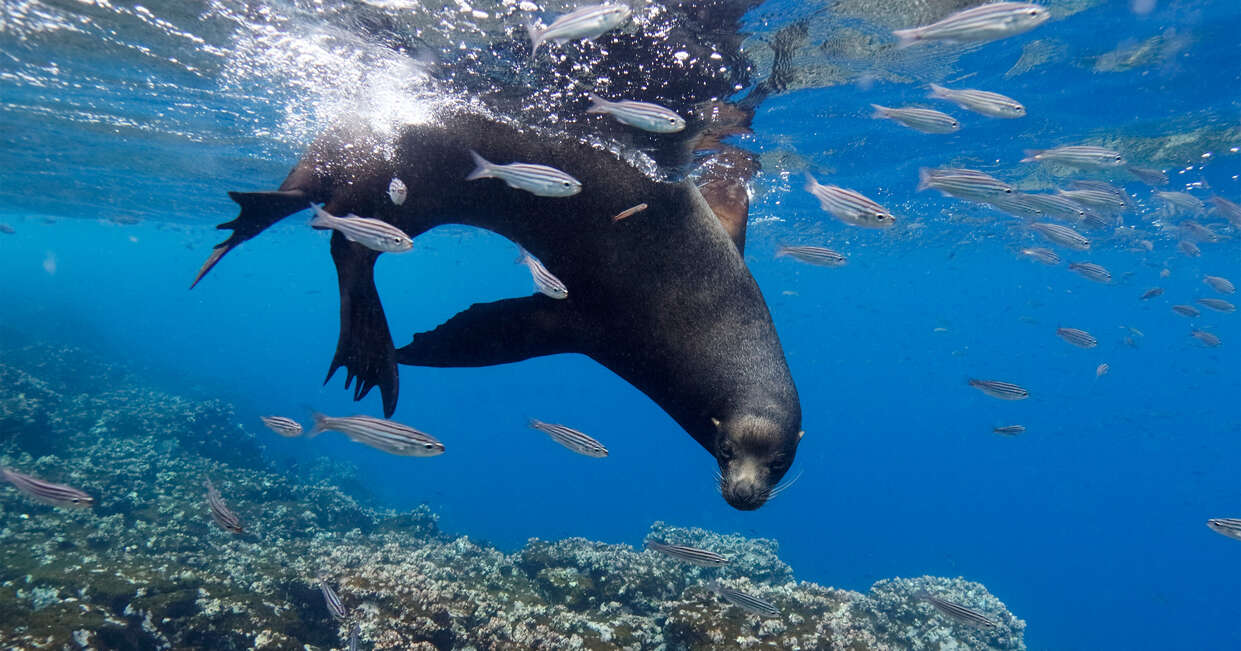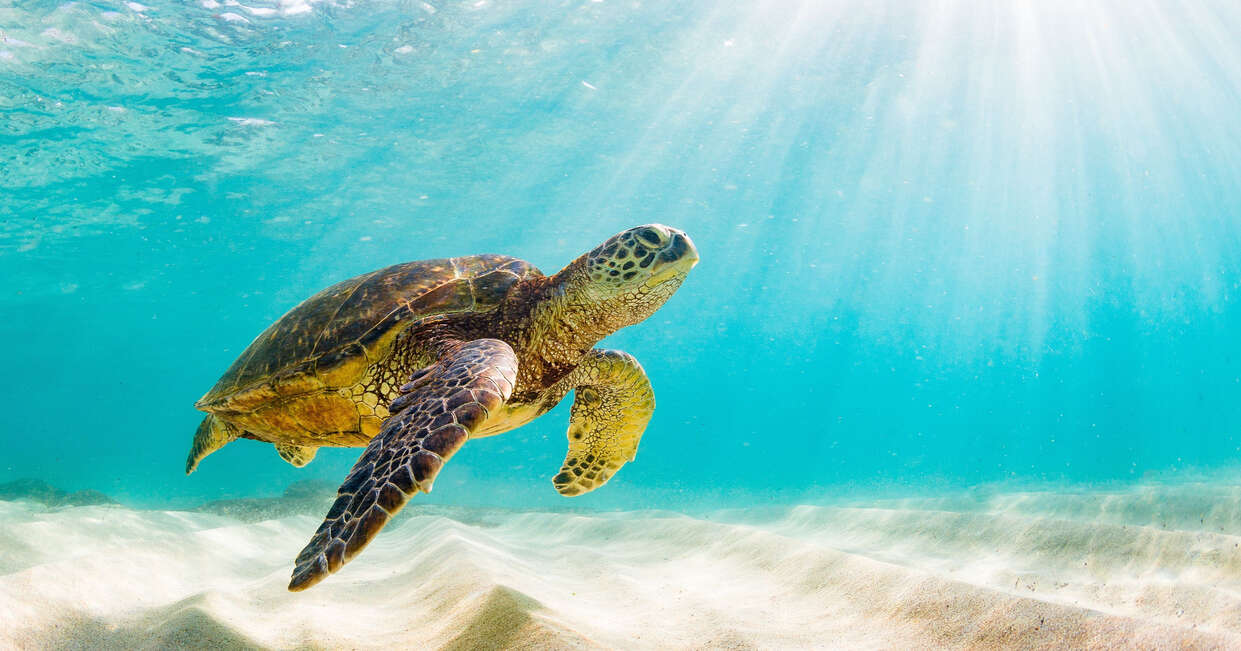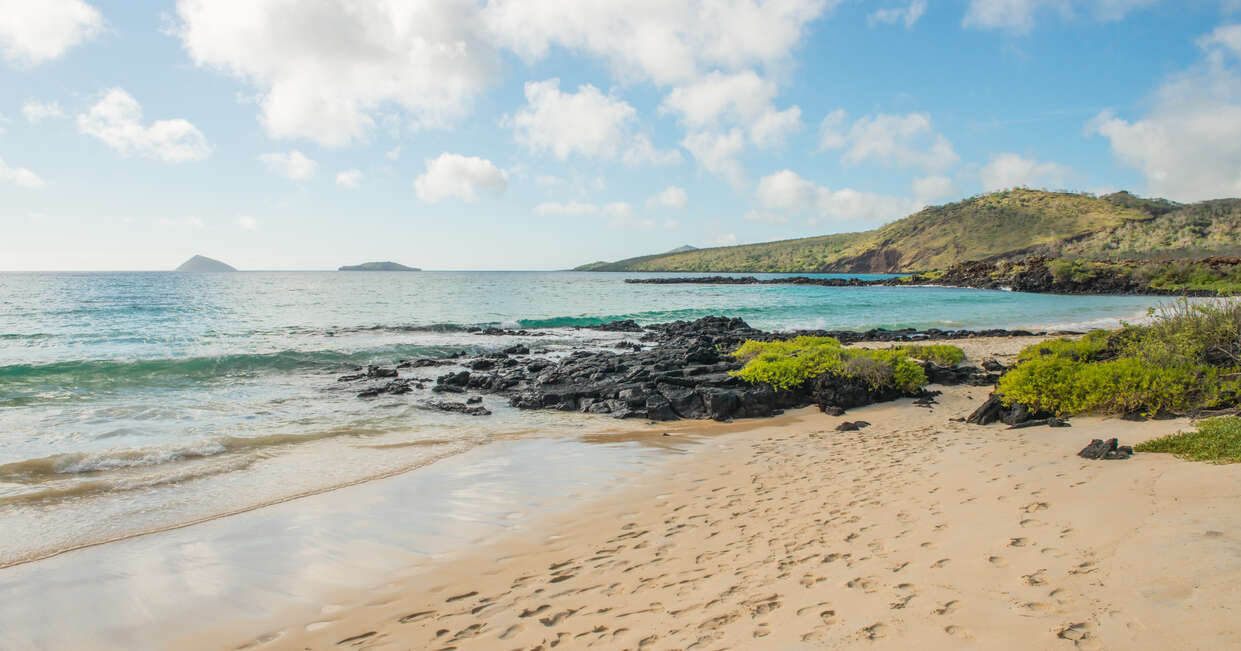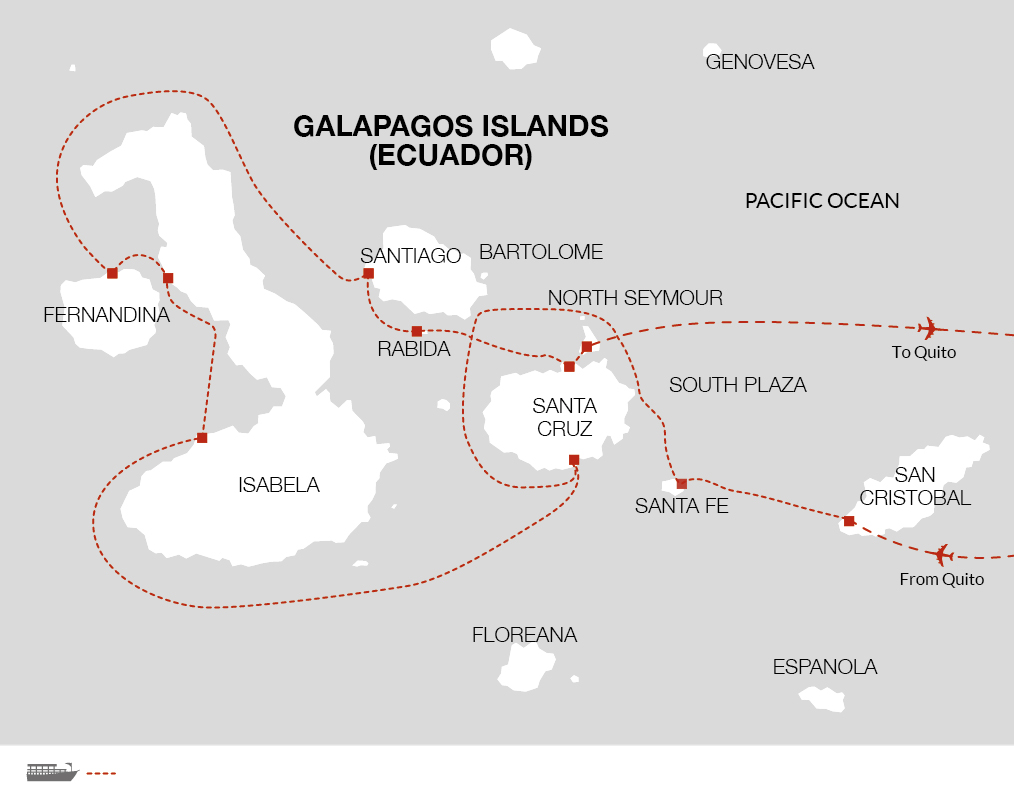Galapagos - Central, West & East Islands aboard the Archipel I
Galapagos - Central, West & East Islands aboard the Archipel I
$7650
Tour Overview
Experience the island chain that has enchanted explorers since Darwin first dropped anchor off its shores. Spend a week exploring the incredible wildlife of the Galapagos archipelago aboard a stylish vessel - the Archipel I. Travelling between the central, west and east islands, you will have the chance to explore from land and from the sea; snorkel with penguins at Vicente Roca and spot frigatebirds at North Seymour, and head to Santa Cruz's verdant highlands to see giant tortoises in their natural environment.
Archipel I Catamaran - Spend seven nights cruising onboard this modern, spacious catamaran with a naturalist guide and experienced crew
Wildlife spotting - Try to find all three distinct species of booby, as well as sea lions, iguanas, Galapagos penguin, giant tortoises and much more
Snorkel and walk - Discover an underwater paradise as well as a volcanic landscape, with daily snorkelling and on-shore excursions
...more ...less
Highlights
Itinerary
Day 1 : Join trip in Puembo, Quito
Location: Quito
Accommodation: Hotel Rincon de Puembo
Accommodation Name: colonial-style property with a large garden and swimming pool
Arrive in Puembo, a quiet rural neighbourhood of Quito located around 20 minutes from the airport and 45 minutes from the downtown city centre. Ecuador's mountain capital is, at 2,850m, the second highest capital in Latin America, lying in a narrow valley at the foot of the Pichincha Volcano. Arriving into the city by plane is quite spectacular as you approach over snow-capped mountains and extinct volcanoes - a window seat is recommended! You will be met on arrival at Mariscal Sucre International Airport (UIO) by a driver to take you to this evening's hotel, where more information will be given to you about tomorrow's schedule. The hotel is a tranquil, colonial-style property with a large garden and swimming pool. It's located in the countryside suburbs of Quito, near the airport; perfect for an early start tomorrow. The hotel can help organise a taxi for you into downtown Quito if you arrive early in the day and wish to visit the city. ...more ...less
Day 2 : Fly to the Galapagos; visit the interpretation centre on San Cristobal Island; board the Archipel I catamaran
Location: San Cristobal Island, Galapagos
Accommodation: Archipel I
Accommodation Name: Archipel I
Meals Included: Breakfast, Lunch, Dinner
Today we transfer to the airport early for our flight to the Galapagos Islands via Guayaquil (refueling stop only, you will not disembark the plane). Lying on the Equator, 970km west of the Ecuadorean coast, the Galapagos National Park is a unique collection of islands, formed by volcanoes over hundreds of thousands of years and consisting of six main islands, 12 smaller islands, and over 40 small islets, each one supporting a distinct and unique flora and fauna, including prehistoric creatures found nowhere else on earth. This desolate and fantastic habitat was discovered in 1535 by Fray Tomas de Berlanga. Charles Darwin visited the islands on the Beagle exactly three hundred years later, in 1835. He observed the total isolation of the giant reptiles and other creatures, and this played a substantial part in his theory of evolution. Of the extraordinary animals to be found in the Galapagos many are reptiles, such as the great tortoise, large land iguanas, numerous lizards and three species of non-poisonous snakes. There are also several species of turtle, which come ashore to mate. Up to three quarters of a million seabirds flock to the islands, including a third of the world's blue-footed boobies, frigatebirds, pelicans, cormorants, albatross and petrels. Only 35cm tall, the Galapagos penguin can be seen swimming among tropical mangroves, whilst offshore it is common to see dolphins, sea lions and fur seals playing in the water. Fearless though not tame, the extraordinary wildlife is often inquisitive and the opportunities for photography are superb. The Galapagos National Park charges a visitor fee of $100 USD (subject to change), payable in cash on arrival, which funds park maintenance and supervision in the Galapagos, as well as ecological study, conservation and infrastructure development in Ecuador's other national parks. Entry fees and the funds they generate for the national park system are among measures taken by the Ecuadorian government to protect its natural heritage. At San Cristobal Airport, a guide will meet us to help us collect our luggage. The easternmost island of the Galapagos archipelago and one of the oldest, San Cristobal's principal town is Puerto Baquerizo Moreno, the capital of the Galapagos. We'll make a visit to the interpretation centre where we will set the scene for the next week's trip, learning more about the Galapagos' history, geology, turbulent past and challenging future. A short, though often hot, uphill trail with steps, leads from the Interpretation Centre to the summit of Frigatebird Hill. Four panoramic viewpoints show Puerto Baquerizo Moreno from above, as well as the bays on both sides of the headland. On clear days even the distant, offshore sculpture of Kicker Rock can be seen. These wooded hilltops are one of the rare places where some magnificent and great frigatebirds form a mixed breeding colony. After our visit to the centre and Frigatebird Hill, we board our stylish vessel for the next week - the Archipel I.
Day 3 : Mingle with the iguanas on Santa Fe Island
Location: Santa Fe Island, Galapagos, South Plaza Island, Galapagos
Accommodation: Archipel I
Accommodation Name: Archipel I
Meals Included: Breakfast, Lunch, Dinner
After breakfast this morning we head out to explore Sante Fe island, giving us a chance to mingle with the iguanas. Located in the southeastern part of the Galapagos, this island is not volcanically formed, and is therefore mostly flat. Scientists theorise that this is the oldest island on the archipelago, and it is home to several endemic species including the Galapagos hawk and Galapagos mockingbird, as well as one of the two land iguana species on the islands. We'll disembark and explore on foot, where giant prickly pear cactus are dotted around. We continue onto South Plaza Island, one of the smallest islands in the Galapagos. A large colony of noisy sea lions, numbering about 1000 bulls, cows and pups, has its prime habitat on the smooth rocks. We will walk along a path through a cactus forest and view a combination of dry and coastal vegetation, populated by land iguanas, which can be seen sunning themselves or feeding on opuntia pads and fruits. Swallow-tailed gulls, which nest on the rugged southern cliffs, are usually seen, along with tropicbirds and Audubon's shearwaters. During the rainy season you can see the red sesuvium turn bright green and the leafless evening-blooming portulaca burst into large yellow flowers, which are loved by the iguanas.
Day 4 : Observe magnificent frigatebirds on North Seymour, and visit Chinese Hat
Location: North Seymour Island, Galapagos, Chinese Hat, Galapagos
Accommodation: Archipel I
Accommodation Name: Archipel I
Meals Included: Breakfast, Lunch, Dinner
Today we set sail for North Seymour Island, just north of Baltra Island, which is home to sea lions, marine iguanas, swallow-tailed gulls, magnificent frigatebirds and blue-footed boobies. North Seymour Island is probably the most exciting island photographically. Birdlife abounds, and close to the trail you will find many nesting pairs and young chicks. North Seymour is also home to the Galapagos' largest colony of frigatebirds. Their mating ritual is an ostentatious display; males expand the red sack at the base of their throat and perch atop a bush with wings fully extended, flapping furiously. Interested females circle overhead, and if so inclined, may join the male on terra firma. Further along the trail we can observe a colony of sea lions. In the afternoon the boat arrives to a small little island off the southern tip of Santiago Island called Sombrero Chino, or 'Chinese Hat', named for its unique shape. Chinese Hat comprises of a tilted cone and lava flows that run down to the coast. Here it is often possible to see Galapagos penguins and the abundant marine life, including rays, turtles and sea lions.
Day 5 : Witness giant tortoise in the wild; visit the Fausto Llorena breeding centre
Location: Santa Cruz Island, Galapagos
Accommodation: Archipel I
Accommodation Name: Archipel I
Meals Included: Breakfast, Lunch, Dinner
In the morning we arrive in Puerto Ayora, on Santa Cruz Island. Santa Cruz is the second largest island in the Galapagos and has the largest population, with Puerto Ayora as its main town. It also boasts the most varied of the islands' vegetation zones: coastal, transition, scalesia, miconia and pampa. The native scalesia forest of El Chato Tortoise Reserve is the best place to search for Galapagos giant tortoises in their most authentic setting. Though it can be quite moist and muddy, the visit will be an adventure, trying to spot the giant creatures silently leave their favourite ponds. While on the mainland, we'll also visit the Twin Craters - found on either side of the road leading to Puerto Ayora. These impressive formations were formed by magma domes, which hardened on the outside while the lava continued flowing inside, leaving huge and empty magma chambers that eventually collapsed, leaving two large holes. The craters lie within a lush scalesia cloud forest, a high-altitude plant species that are endemic to the Galapagos. This area is also home to the carpenter finch, which uses tools to search for food. This afternoon we visit the Fausto Llerena Breeding Centre, where we can observe tortoises that come from various islands of the archipelago - at Fausto Llerena they are breeding tortoises only to repopulate areas where their populations have been affected by non-native wildlife (predominantly feral dogs). One of the main attractions here is the embalmed Lonesome George - estimated to have died at between 93 and 109 years of age, Lonesome George is recognised as the last of its kind, and as a symbol of the efforts invested into conserving endangered species.
Day 6 : Discover Isabela Island
Location: Isabela Island, Galapagos
Accommodation: Archipel I
Accommodation Name: Archipel I
Meals Included: Breakfast, Lunch, Dinner
We land on Isabela Island today, and walk to Moreno Point this morning. Located on the north coast between the volcanos of Sierra Negra and Cerro Azul, the trail runs along a solidified lava flow into a complex of coastal lagoons, where we'll find an abundance of birdlife around the lakes and mangroves. In the afternoon we'll Visit Urbina Bay, located at the base of Alcedo Volcano. Hike the trail to get a view of the caldera. Walk among a massive marine reef that was raised out of the water in 1950 during an uplift, and see sculptures of dried coral and other ocean formations while touring the area on foot. Urbina Bay also offers great opportunities to see land iguanas that have astonishingly yellow skin, flightless cormorants, land tortoises as well as marine turtles and rays.
Day 7 : Find the flightless cormorant on Fernandina Island; snorkel at Vicente Roca Point
Location: Fernandina Island, Galapagos, Isabela Island, Galapagos
Accommodation: Archipel I
Accommodation Name: Archipel I
Meals Included: Breakfast, Lunch, Dinner
This morning's excursion takes us to Punta Espinoza on Fernandina, the youngest of the Galapagos Islands. Witness the large colony of marine iguanas and a variety of bird life, including the unique flightless cormorant. This bird had to adjust its way of survival and perfect its skills of finding food in the ocean. Their wings, tails and feet progressively adapted for swimming. To see these birds is to witness evolution happening right in front of you. We'll tour a number of different trails and follow the path along the beach and across lava flows, for a unique opportunity to explore one of the least-visited areas of the Galapagos. While having lunch we sail to Vicente Roca point back on Isabela Island, just at the mouth of Isabela's seahorse-shape. From small panga boats we'll enter a dark cave below a spectacular arch, accompanied by roaring echoes of the waves. Just around the corner the collapsed amphitheatre of Volcan Ecuador offers another impressive view. The calmer waters of the coves are well-protected against the ocean swell and are fairly cold, but a great place for snorkelling amongst various species of shark, penguins, puffer fish and seahorses.
Day 8 : Enjoy Egas Port and explore the red-sand beaches and sea lion colonies of Rabida
Location: Santiago Island, Galapagos, Rabida, Galapagos
Accommodation: Archipel I
Accommodation Name: Archipel I
Meals Included: Breakfast, Lunch, Dinner
In the morning, we will travel to the black-sand beach of Egas Port on Santiago Island to witness the striking and fascinating giant lava formations. Very few plants have managed to survive on this island due to its harsh environment and relatively new lava flow. Take an afternoon excursion to the red sand beaches of Rabida to see a lagoon and the famous bachelor sea lion colony. This area is known for its birdlife, including pelicans, white-cheeked pintails and boobies. Explore the trails of Rabida; a short path leads to a saltwater lagoon; another trail goes past the lagoon to the interior, where the revered palo santo trees grow. When burned, the branches of this tree give off a pleasing aroma and ward off mosquitoes. Grab a snorkel and discover many species of fish and other marine life. Keep an eye out for white-tip sharks and sea lions.
Day 9 : Explore Black Turtle Cove; fly back to Quito
Location: Black Turtle Cove, Galapagos, Quito
Accommodation: Hotel Rincon de Puembo
Accommodation Name: Hotel Rincon de Puembo
Meals Included: Breakfast
Explore the mangrove lagoon at Black Turtle Cove by a small panga. In the afternoon, we will transfer to the airport for our flight to Quito. On arrival back on the mainland, you'll have a transfer to the hotel for your final night in Ecuador.
Day 10 : Trip ends in Puembo, Quito
Location: Quito
Meals Included: Breakfast
The trip ends after breakfast at the hotel in Puembo, Quito. There are no activities planned today, so you are free to depart at any time. Pick-up times for your airport transfer to Mariscal Sucre International Airport (UIO) will be re-confirmed locally. If your flight is departing later in the day, luggage storage facilities are available at the hotel. If you would like to book additional nights in Quito at the end of your stay, these can be arranged either at the hotel in Puembo, or in a hotel in downtown Quito. We recommend spending extra time in Quito, or adding to your nature-based holiday by booking our four-night Amazon extension package (trip code: AE).
What's Included
-
Accommodation
Accommodation is provided at Hotel Rincon de Puembo and aboard the Archipel I catamaran.
-
Meals
The tour includes 9 breakfasts, 7 lunches, and 7 dinners.
-
Guided Tours
Guided tours and excursions are included throughout the trip, including visits to various islands and wildlife observation.
-
Transfers
Transfers from Quito Airport to the hotel and back are included.
What's Not Included
-
Galapagos National Park Fee
The Galapagos National Park charges a visitor fee of $100 USD, payable in cash on arrival.
-
Personal Expenses
Personal expenses such as souvenirs, additional meals, and drinks are not included.
-
International Flights
International flights to and from Ecuador are not included.
-
Travel Insurance
Travel insurance is not included and is recommended for all travelers.
Meals
Breakfasts: 9
Lunches: 7
Dinners: 7
Mode of Transport
Begin your journey with a flight from Quito to the Galapagos Islands, followed by a week-long cruise aboard the Archipel I catamaran. Enjoy daily excursions and transfers by small panga boats to explore the islands' unique wildlife and landscapes.
Accommodation
Experience the tranquility of Hotel Rincon de Puembo in Quito, a colonial-style property with a large garden and swimming pool, perfect for relaxation. Onboard the Archipel I catamaran, enjoy a comfortable and stylish stay while exploring the Galapagos Islands.
Check out our Q&As
-
What kind of wildlife can I expect to see on this tour?
During the tour, you can expect to see a variety of wildlife including Galapagos penguins, blue-footed boobies, magnificent frigatebirds, sea lions, marine iguanas, land iguanas, Galapagos hawks, Galapagos mockingbirds, giant tortoises, and flightless cormorants. The islands are also home to numerous seabirds, turtles, and marine life such as rays and sharks. ...more ...less
-
What activities are included in the tour?
The tour includes a range of activities such as daily snorkeling, on-shore excursions, hiking trails, and wildlife observation. You will visit various islands, explore unique geological formations, and have opportunities for photography and learning about the islands' history and ecology. ...more ...less
-
Will there be opportunities for snorkeling during the tour?
Yes, there are daily snorkeling opportunities included in the tour, allowing you to explore the rich marine life around the Galapagos Islands.
-
What is the significance of the Fausto Llerena Breeding Centre?
The Fausto Llerena Breeding Centre is significant for its efforts in breeding tortoises to repopulate areas where their populations have been affected by non-native wildlife. It is also home to the embalmed Lonesome George, the last of his kind, symbolizing conservation efforts for endangered species. ...more ...less
-
What is unique about the wildlife on Fernandina Island?
Fernandina Island is home to a large colony of marine iguanas and the unique flightless cormorant, which has adapted its wings, tails, and feet for swimming, showcasing evolution in action.
-
What can I expect to see at Black Turtle Cove?
At Black Turtle Cove, you will explore a mangrove lagoon by a small panga, where you can observe the rich marine life and possibly see turtles and other wildlife in their natural habitat.
-
I'm going on a walking/cycling trip-do I need to train?
It will depend on the grade and how fit you already are. Check the trip page for details of the walking or cycling grade and how far you’ll be walking/cycling each day. For moderate or challenging trips in particular we’d recommend doing some walks or cycles before you leave to build up your fitness and prepare you for the distances being covered.
-
Who will be my travelling companions on the tour?
We have a wide range of ages nationalities on our small group trips and they come from all walks of life.
-
Should I get travel insurance?
Yes–it is a condition of booking that you are fully insured when travelling with us
-
How long has the tour company been trading?
At Explore, we're the experts in adventure travel. Our small group adventure holidays have been running since 1981. Today, Explore is one of the most trusted travel companies in the UK with over 500 trips to more than 120 countries.
-
Can I join the tour once it has departed?
Yes, but there are no concessions for doing so, and we must have a record in your booking advising as such before the trip departs.
-
Am I contributing to any charity by booking the tour?
Being a responsible company is a large statement, something that has to be entwined within the very fibre of a company. Discover the charities and partnerships we support as part of this at https://www.explore.co.uk/about/sustainability/charities-and-partners
-
What happens if I need to change my holiday date once I’ve booked?
We want to be as clear as and as honest as possible about what happens if you decide to that you no longer wish to travel on your trip. Our booking conditions have details of the costs you’ll incur when you cancel-these charges depend on how long it is before your planned departure.
-
What is the accommodation like?
We choose comfortable accommodation in the best locations possible. We opt for small, local and family-run accommodation where we can, as opposed to large chain hotels. We typically use hotels that are the equivalent of European 3-star, and you’ll usually have an en suite room. Occasionally, where we want to get off the beaten trail we may stay in more basic accommodation.
-
What Ethical Travel credentials does the tour company have?
Sustainability is embedded within the fibre of Explore, it emanates from the inside out. But as we enter a new decade it is clearer than ever that our world needs help, and Explore has created a sustainability strategy based on the 2015 UN’s Sustainable Development Goals.
-
What policies are in place for Covid-19?
Our flexible booking and safety policies mean you're protected before and during your travels with us. Receive a full refund if your trip is cancelled, transfer your trip free of charge up to 10 days before departure minus any irrocoverable costs.
-
Do I need to be very fit to book with you?
All our trips require some level of active participation. This could be on a cultural trip, trek, safari, expedition or voyage. It is in the interests of all members of the group that everyone should be capable of fully participating in the activities of their chosen trip.
-
What documents will I receive before I travel?
Final documents will include a comprehensive trip itinerary, climate and country information, budgeting and packing advice visa and passport information and details on optional activities available.
-
Do you operate a “single share” option and how does it work?
Yes on most of our trips. Most trips are based on customers sharing twin-bedded rooms. If you book a group trip as an individual, you will share a room with someone of the same sex. However, on many trips we offer the opportunity to pay a supplement to pre-book a single room, known as our single room option. On some trips a single room will be provided every night, on others it will be provided o
-
Do we have to be vaccinated against Covid-19 to travel
It’s now a condition of booking a trip with us that customers should have one of the following before they travel - — Be vaccinated against COVID, having received the full recommended course, and allowing enough time for immunity to take effect. Full vaccination includes any booster required to keep the vaccine valid. — Have taken a negative test (rapid antigen or PCR) within 72hrs of departure.
-
Will the accommodation included meet local health and safety regulations?
Explore will only offer hotels that have specific COVID-19 protocols in place and comply with local government guidelines. We will ensure these measures include; enhanced room cleaning, ventilation, social distancing, regular cleaning and disinfection of high frequency touch points in public areas, food safety, staff re-training and minimising contact within the properties.
Reviews of this operator
1 Select your preferred date
Book with Confidence
-
Free Date Changes
Explore! allows you to make 1 free date changes, as long as the change is made at least 70 days before the start of the tour.
-
Low Deposit
Explore! requires a minimum deposit of 10% or the full booking value, whichever is less, with the final balance not due until 70 days before departure.
-
Cancellation Policy
We don't charge a cancellation fee, here is a summary of explore! charges.
Up to 70 days before tour starts: Forfeit 100% of deposit.
At 69 days before tour starts: Forfeit 30% of booking price.
At 41 days before tour starts: Forfeit 60% of booking price.
At 27 days before tour starts: Forfeit 90% of booking price.
At 13 days before tour starts: Forfeit 100% of booking price.
Enquire for Extra Savings
Rated 5* on Trust Pilot & ABTA Protected.
Galapagos - Central, West & East Islands aboard the Archipel I
10 Days Starting and ending in Quito, Ecuador
Visiting: Quito, San Cristobal Island, Galapagos, Santa Fe Island, Galapagos, South Plaza Island, Galapagos, North Seymour Island, Galapagos, Chinese Hat, Galapagos, Santa Cruz Island, Galapagos, Isabela Island, Galapagos, Fernandina Island, Galapagos, Santiago Island, Galapagos, Rabida, Galapagos, Black Turtle Cove Galapagos ...more ...less
Tour operator:
Tour code:
GA7A
Guide Type:
Fully Guided
Age range:
16-0


